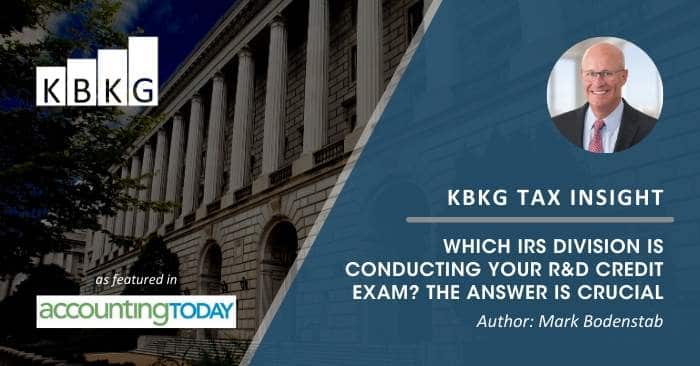As featured in Accounting Today
The Internal Revenue Service (IRS) collected nearly $3.4 trillion through more than 160 million individual and business tax returns during Fiscal Year 2018. For all this revenue, approximately 991,000 returns were examined, representing less than one percent of all tax returns filed. The number of examinations conducted to uphold enforcement has been declining year over year due to staffing attrition.[i]
Considering the need to preserve collections while undergoing any further attrition, IRS management must apply its resources to optimize efficiency. One factor it uses to measure examination efficiency is the percentage of recommended adjustments during audit; results are judged as either “change” or “no-change.” High numbers of no-change audits are deemed to be a poor use of limited resources. You can see that this metric might influence the decision process on what return or issue to examine.
The research credit is just one of the hundreds of issues that IRS examiners can select. For decades, the credit has been subject to a wide gulf of interpretation, and hence predictable as an issue ripe for adjustments. Now consider that the IRS has notified you that your company has been selected for an audit of your filed research credit. Do you know who will be examining your company?
There are four principal examination divisions in the IRS:
- Wage and Investment (W&I) is responsible for personal tax returns.
- Tax-Exempt and Government Entities (TEGE) is responsible for community organizations, universities, pension funds, and local governments.
- Large Business and International (LB&I)
- Small Business/Self Employed (SBSE)
The last two divisions are responsible for the audit of research credit filings.
Large Business and International (LB&I)
LB&I audits taxpayers with assets greater than $10 million. LB&I employs about 2,870 examiners, along with a large percentage of roughly 150 engineers, to oversee nearly 210,000 taxpayers. Many of these examiners are tasked to audit the research credit, and LB&I has decades of experience reviewing very large research credit filings.
The best way to efficiently examine the research credit issue has been the subject of many studies, debates, and proposals over the years. LB&I frequently applies a team approach in the examination of the research credit. In addition to an assigned Revenue Agent, the exam team will likely include specialists, such as Engineers or Computer Audit Specialists (CAS). Engineers have degrees in various engineering sciences, and many have industry experience outside of the IRS. A CAS is a Revenue Agent with specific training in computer applications and statistical sampling methods that can expedite data sharing between the client and the IRS. LB&I also has “Practice Areas” which focus on specific areas of tax compliance. The R&D Credit falls under the Business Credits practice area, and its Subject Matter Experts (SME) with specific industry or credit knowledge may provide additional support to examination teams. Depending on the size and complexity of the particular company and credit, teams are composed of multiple Agents and Specialists.
In early 2017, LB&I developed a new method of identifying and managing compliance work and selected the first thirteen such “Campaigns.” The intent was to allocate its scarce resources to its most significant challenges. It has long been recognized within the IRS that examining issues involving research and experimental expenditures consumed substantial resources of both the taxpayers and examiners. In 2018, LB&I instituted its latest multidisciplinary R&D Credit Team, which was tasked to improve research credit audits.
This past January, the research credit was added to the list of campaigns. The responsibility for this new approach is jointly owned by Enterprise Activities and the Eastern Compliance Area’s Director of Field Operations for Engineering, demonstrating the long history of engineering engagement in the credit. In turn, two very experienced senior managers are assigned to shepherd this new campaign to full implementation. It appears that personnel assigned to this new R&D Campaign will likely be responsible for establishing guidelines and centralized risking for which filed/amended LB&I research credits will be examined. Overall, one can be optimistic that this LB&I campaign will improve consistency across the country and focus on just the highest risked returns, to the satisfaction of those being examined as well as the IRS.
Small Business/Self Employed (SBSE)
Of all the tax returns examined by the IRS during FY 2018, more than half were conducted by SBSE. SBSE is responsible for auditing small business entities and Estate and Gift returns. The SBSE business taxpayer is one with assets of less than $10 million. SBSE employed approximately 4,600 SBSE examiners to audit almost 500,000 returns out of approximately 9 million small business filers.
SBSE became more engaged in the examination of research credit in just the last ten years. When a spike in filed research credits was identified, SBSE responded and created a task force to address the situation. As the task force stood up, there was meaningful collaboration between SBSE and LB&I, the latter sharing its considerable experience in research credit examinations. Unlike LB&I, an SBSE audit was assigned to a single revenue agent. In some areas of the country where resources were available, LB&I engineers provided limited assistance to SBSE examinations. To address the continuing plethora of small-case research credit examinations, SBSE issued a directive in 2016 that all returns with a research credit must be reviewed by a team of analysts. Unfortunately, the desired consistency and efficiency never materialized. So, in 2018, SBSE formed three dedicated teams, each assigned geographically: East, Midwest, and West. The Division recruited and trained volunteer examiners to conduct these research credit audits directly. Early results indicate tendencies to disallow large portions, and sometimes all, of filed research credits, leaving taxpayers with the necessity to seek mediation or negotiation. These relatively new research credit examiners appear to be at the beginning of a similar learning curve to that which LB&I examiners experienced in the previous decades.
KBKG Insight: If your filed research credit is selected for audit, the size of your company will likely determine the experience level of your assigned examiner. Regardless of which Division your company falls under, your examination will be comprehensive. Be prepared with sound explanations and documentation and seek advice from a trusted practitioner.
Learn more about the R&D tax credit and/or contact our R&D specialists to see if you qualify.
KBKG Provides Unique R&D Audit Defense Service
Did you claim the Research & Development (R&D) Tax Credit and are now under audit? Regardless of how you got here, we can help. With decades of research credit audit experience, we fully understand IRS audit techniques and procedures. Our firm can guide you through the audit process in the least amount of time while sustaining the maximum credit possible. » Learn more about our R&D audit defense service
Author: Mark Bodenstab
[i] TREASURY INSPECTOR GENERAL FOR TAX ADMINISTRATION
Trends in Compliance Activities Through Fiscal Year 2018
September 9, 2019 Reference Number: 2019-30-063
About the Author
 Mark Bodenstab – Director
Mark Bodenstab – Director
New Hampshire
Mark Bodenstab is a Director of the Research & Development Tax Credit Services, operating out of New Hampshire. Mark brings knowledge of many aspects of R&D from his 20+ years in the private sector as well as 14 years with the Internal Revenue Service (IRS). He joined the IRS as a General Engineer to provide technical and valuation support in the examination of large corporate tax filings. He has experience in a wide range of engineering issues, including the complicated credit for increasing research. » Full Bio


